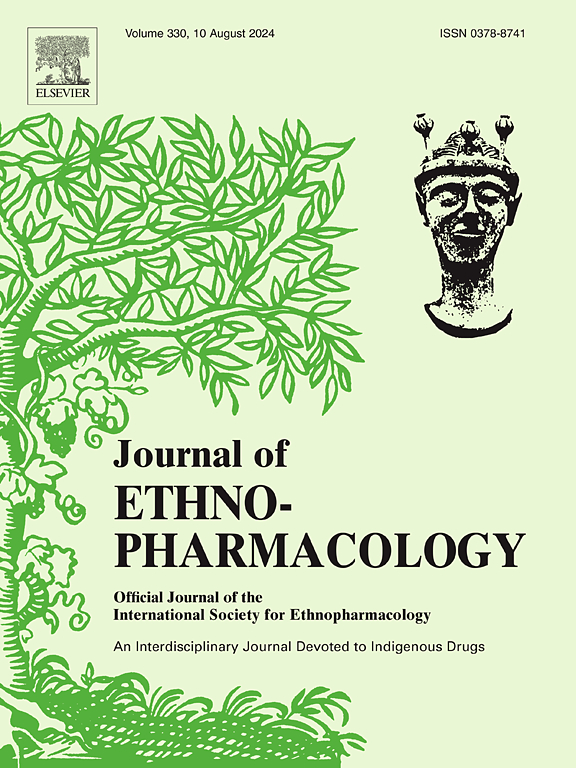Evaluating the efficacy and safety of emodin, luteolin, and paeonol combination from Dahuang Mudan decoction in ameliorating ulcerative colitis
IF 4.8
2区 医学
Q1 CHEMISTRY, MEDICINAL
引用次数: 0
Abstract
Ethnopharmacological relevance
Dahuang Mudan Decoction is a classic Chinese medicine prescription for treating ulcerative colitis (UC). Previous studies have shown that Dahuang Mudan Decoction has preventive and therapeutic effects on mice with dextran sulfate sodium (DSS) induced colitis.
Aim of the study
The objective of this research endeavor was to ascertain the most efficacious synergistic blend of Emodin, Luteolin, and Paeonol, the main active ingredients in Dahuang Mudan Decoction, in alleviating UC. Additionally, it sought to elucidate the underlying therapeutic mechanisms and evaluate the safety of the combined components.
Materials and methods
Employing Emodin, Luteolin, and Paeonol as starting materials, the optimal combination was selected by orthogonal design. Basic pharmacodynamics was observed in mouse model of UC induced by DSS. The pathological changes of the colon were observed using hematoxylin and eosin (H&E) staining. The changes of cytokines and proteins related to inflammation and intestinal barrier function were detected by WB, Alcian blue staining, immunofluorescence, immunohistochemistry and related kits. Subsequently, 16S rRNA sequencing was used to observe changes in the intestinal flora. To evaluate the therapeutic effect and potential mechanism of the optimal monomer composition on UC mouse model. Finally, we performed toxicity tests as part of the safety assessment of the combination of the three monomers.
Results
The different combinations of Emodin, Luteolin, and Paeonol alleviated DSS-induced colitis to varying degrees. The ELP5 group (Emodin 5 mg/kg + Luteolin 5 mg/kg + Paeonol 15 mg/kg) and ELP9 group (Emodin 15 mg/kg + Luteolin 15 mg/kg + Paeonol 75 mg/kg) had the most significant mitigation effect on UC mice. Mechanistically, the monomeric composition provides a comprehensive treatment for UC by addressing multiple aspects, including anti-inflammatory and antioxidant effects, repairing the damaged intestinal barrier, restoring the intestinal flora structure, and regulating short-chain fatty acid levels. In addition, the combination of Emodin, Luteolin and Paeonol exhibited a more significant effect on DSS-induced colitis compared to the individual components, indicating a synergistic effect among them. In the single-dose toxicity test, no obvious abnormalities were found in the general state or major organs of the mice. In repeated toxicity tests, it was found that the combined use of three monomers had less effect on organ index, hematology and serum biochemical indexes than that of a single compound. Pathological examination showed that the three monomers had certain toxicity to mouse liver, kidney and lung when used alone and in large doses for a long time, and the toxicity was significantly reduced after combined use.
Conclusions
We have determined the optimal combination of three active ingredients in Dahuang Mudan Decoction to alleviate DSS induced colitis in mice by inhibiting intestinal inflammation and oxidative stress, repairing impaired intestinal barrier function, and regulating intestinal flora disturbance. The results of single administration toxicity test proved the safety of the three monomers combined, and repeated administration toxicity test clarified the safe dose range of the combined administration, and also revealed that the combined therapy exhibited superior safety compared to monotherapy.

求助全文
约1分钟内获得全文
求助全文
来源期刊

Journal of ethnopharmacology
医学-全科医学与补充医学
CiteScore
10.30
自引率
5.60%
发文量
967
审稿时长
77 days
期刊介绍:
The Journal of Ethnopharmacology is dedicated to the exchange of information and understandings about people''s use of plants, fungi, animals, microorganisms and minerals and their biological and pharmacological effects based on the principles established through international conventions. Early people confronted with illness and disease, discovered a wealth of useful therapeutic agents in the plant and animal kingdoms. The empirical knowledge of these medicinal substances and their toxic potential was passed on by oral tradition and sometimes recorded in herbals and other texts on materia medica. Many valuable drugs of today (e.g., atropine, ephedrine, tubocurarine, digoxin, reserpine) came into use through the study of indigenous remedies. Chemists continue to use plant-derived drugs (e.g., morphine, taxol, physostigmine, quinidine, emetine) as prototypes in their attempts to develop more effective and less toxic medicinals.
 求助内容:
求助内容: 应助结果提醒方式:
应助结果提醒方式:


